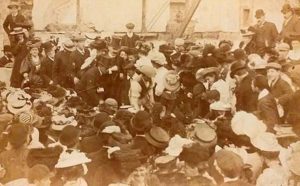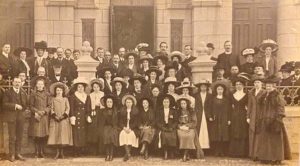Mapping Methodism – Trelowarren Street, United Methodist Free Church, Camborne
Categories Mapping Methodism1 Comment
Camborne is a town in Cornwall. This profile of Camborne Trelowarren Street United Methodist Church has been compiled by David Thomas.
Let’s wander just a short distance from the Camborne Bible Christian chapel in Rosewarne Road into Trelowarren Street and today facing us there stands Costa Coffee. Older residents will of course remember it as the Trelowarren Street Methodist Church, opened in 1909. The chapel was built as a United Methodist Church following the 1907 denominational Union of three groups, the Bible Christians, the United Methodist Free Church and the Methodist New Connexion, the latter denomination being a breakaway group from the Wesleyans in 1797.
The new chapel was built in a very grand and attractive Edwardian gothic architectural style, very much in a pseudo ‘Strawberry Hill’ mode and is very appealing to the eye. The front of the acquired site was formerly occupied on the southern side of the street by one of the two fruit shops kept by George Noble which was then pulled down.
 The postcard image was taken in 1908 on the occasion of the laying of the chapel foundation memorial stones, following that demolition. Just left of the centre top of the view, in top hat, is the minister, Revd F J Highley Coles. The crowd’s attention is focussed on the stone laying. My own great grandmother Ellen Jane Thomas, nee Branch (1863-1927) is probably among the crowd somewhere as she lived in Moor Street and attended this chapel.
The postcard image was taken in 1908 on the occasion of the laying of the chapel foundation memorial stones, following that demolition. Just left of the centre top of the view, in top hat, is the minister, Revd F J Highley Coles. The crowd’s attention is focussed on the stone laying. My own great grandmother Ellen Jane Thomas, nee Branch (1863-1927) is probably among the crowd somewhere as she lived in Moor Street and attended this chapel.
I wonder how many punters of Costa are aware of the rich history and the stupendous architecture that surrounds them as they sip their beverage?
There is however much more to be learned about the complicated Nonconformist religious history of this narrow oblong site that stretches back to Gas Street in a southerly direction and more will be revealed in due course.
 The opening day of many chapels was not often recorded photographically, as many of them were constructed before the days of commercial photography became more common. However, Trelowarren Street chapel at Camborne was the last chapel built in the town in 1909 and was sometimes known locally as ‘new chapel’. Here we see the chapel congregation in the forecourt on that very special occasion in that year. The minister, Revd F J Highley Coles is in the back row towards the top right. One of the chapel forms has been brought outside and placed on the pavement for five of the younger female adherents to sit on. This is very much a staged commemorative photograph by a professional photographer, though his name is not on the back of the postcard and to take the picture he must have placed his heavy glass plate camera right in the middle of Trelowarren Street where there were tram lines and much horse drawn traffic! There were no instant mobile phone shots 111 years ago!
The opening day of many chapels was not often recorded photographically, as many of them were constructed before the days of commercial photography became more common. However, Trelowarren Street chapel at Camborne was the last chapel built in the town in 1909 and was sometimes known locally as ‘new chapel’. Here we see the chapel congregation in the forecourt on that very special occasion in that year. The minister, Revd F J Highley Coles is in the back row towards the top right. One of the chapel forms has been brought outside and placed on the pavement for five of the younger female adherents to sit on. This is very much a staged commemorative photograph by a professional photographer, though his name is not on the back of the postcard and to take the picture he must have placed his heavy glass plate camera right in the middle of Trelowarren Street where there were tram lines and much horse drawn traffic! There were no instant mobile phone shots 111 years ago!
Among local families in the early days who supported this chapel were the Banfield and Sowell families. The Banfields were tailors and the Sowells grocers, the latter having a shop only a few doors west of the chapel in Trelowarren Street. The people cluster around the fine granite gate posts, which have fortunately survived into the 21st century.
 A lovely postcard image of Trelowarren Street chapel, Camborne by W J Caddy of Redruth in about 1910 and just after it was completed in 1909. I call this ‘pepperpot’ Gothic par excellence!! The quality of the granite facade is a fine example of the stonemason’s skill and we see the building with its original heavy doors and gothic railings. Everything looks very neat and tidy. The forecourt was formerly the site of George Noble’s fruit shop.
A lovely postcard image of Trelowarren Street chapel, Camborne by W J Caddy of Redruth in about 1910 and just after it was completed in 1909. I call this ‘pepperpot’ Gothic par excellence!! The quality of the granite facade is a fine example of the stonemason’s skill and we see the building with its original heavy doors and gothic railings. Everything looks very neat and tidy. The forecourt was formerly the site of George Noble’s fruit shop.
After the construction of this chapel the town of Camborne then possessed two large United Methodist chapels (this one and North Parade) and two large Wesleyan ones (Wesley and Centenary). Not many Cornish towns could boast that, with the possible exception of Penzance.

So frustrating knowing that there is probably a load of relatives in this photo, and not able decipher which. Great bit of reading though. Thank you Dave Thomas.